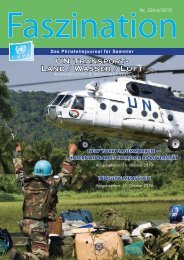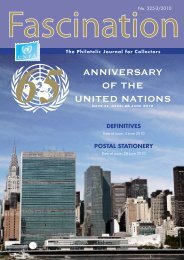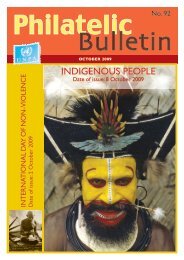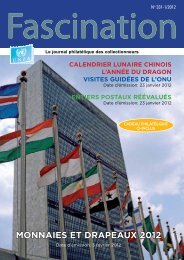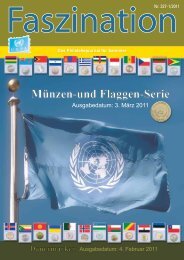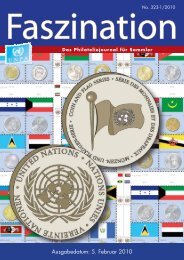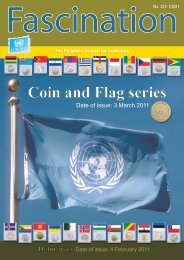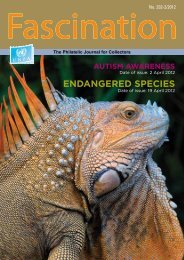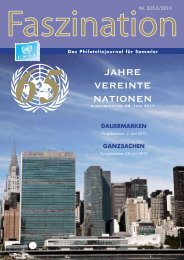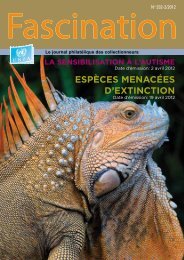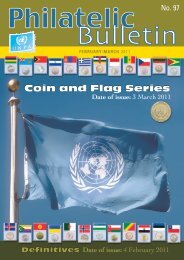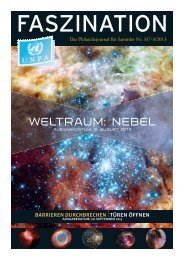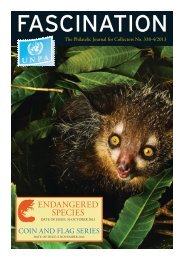Bulletin 104 - United Nations Postal Administration
Bulletin 104 - United Nations Postal Administration
Bulletin 104 - United Nations Postal Administration
You also want an ePaper? Increase the reach of your titles
YUMPU automatically turns print PDFs into web optimized ePapers that Google loves.
WORLD HERITAGE - AFRICA<br />
Item No. 301.3901<br />
45 cents - <strong>United</strong> Republic of Tanzania:<br />
Kilimanjaro National Park<br />
Kilimanjaro National Park, established in 1973, covers<br />
an area of some 75,575 hectares. At 5,895 metres,<br />
Kilimanjaro is not only the highest point in Africa,<br />
but also one of the largest volcanoes in the world.<br />
This volcanic massif stands in splendid isolation<br />
above the surrounding plains, with its snowy<br />
peak looming over the savannah. The mountain is<br />
encircled by mountain forest. Numerous mammals,<br />
many of them endangered species, live in the park.<br />
Mount Kilimanjaro has three main volcanic peaks,<br />
Kibo, Mawenzi and Shira. The mountain has five<br />
main vegetation zones from the lowest to the<br />
highest point: lower slopes, montane forest, heath<br />
and moorland, alpine desert and summit. The whole<br />
mountain, including the montane forest belt, is very<br />
rich in species, in particular mammals; however,<br />
many are critically endangered or near extinction.<br />
Threats to the property include increasing and<br />
cumulative stress from sources such as adjacent<br />
land use, downstream effects of air and water<br />
pollution, invasive species, fire and climate change.<br />
Kilimanjaro National Park was designated a World<br />
Heritage site in 1987.<br />
Item No. 301.3902<br />
m a l i : o l d t o w n s o f d j e n n é<br />
World Heritage - Africa<br />
<strong>United</strong> <strong>Nations</strong> 2012<br />
$1.05 - Mali: Old Towns of Djenné<br />
45¢<br />
<strong>United</strong> <strong>Nations</strong> 2012<br />
World Heritage - Africa<br />
U n i t e d R e p U b l i c o f t a n z a n i a :<br />
K i l i m a n j a R o n a t i o n a l p a R K<br />
$1.05<br />
Djenné, chief town of the Djenné Circle is one of<br />
the oldest towns of sub-Saharan Africa. Inhabited<br />
since 250 B.C., Djenné became a market centre<br />
and an important link in the trans-Saharan gold<br />
trade. Its traditional houses, of which nearly 2,000<br />
have survived, are built on hillocks (toguere) as<br />
protection from the seasonal floods.<br />
The cultural site “Old Towns of Djenné” is a<br />
property comprising four archaeological sites,<br />
namely, Djenné-Djeno, Hambarkétolo, Kaniana and<br />
Tonomba, along with the old fabric of the present<br />
town of Djenné. The property, which covers an area<br />
of 48.5 hectares and is divided into ten districts, is<br />
an ensemble that over many years has symbolized<br />
the typical African city. It is also particularly<br />
representative of Islamic architecture in sub-<br />
Saharan Africa.<br />
The property is characterized by the intensive<br />
and remarkable use of earth specifically in its<br />
architecture. The mosque, which is of great<br />
monumental and religious value, is an outstanding<br />
example of this. The town is renowned for its civic<br />
constructions, with the distinctive style of verticality<br />
and buttresses as well as the elegant monumental<br />
houses with intricate facades.<br />
The property “Old Towns of Djenné” still retains the<br />
archaeological, historic and religious outstanding<br />
universal values which justified its inscription on<br />
the UNESCO World Heritage List (1988).<br />
Item No. 501.3903<br />
<strong>Nations</strong> Unies 2012<br />
F.s. 0,85 - Democratic Republic of the<br />
Congo: Virunga National Park<br />
F.S. 0,85<br />
Patrimoine mondial - L’Afrique<br />
RépUbliqUe démocRatiqUe dU congo :<br />
p a R c n a t i o n a l d e s V i R U n g a<br />
Virunga National Park, covering an area of 790,000<br />
hectares, lies in the north-east of the Democratic<br />
Republic of the Congo, on the border with Uganda<br />
and Rwanda. It comprises an outstanding diversity<br />
of habitats ranging from swamps and steppes,<br />
savannas and lava plains, lowland and forests, to<br />
high-altitude glaciers and mountain peaks. It was<br />
inscribed on the World Heritage List in 1979.<br />
Virunga National Park presents some of the most<br />
dramatic mountain scenery in Africa. The rugged<br />
Ruwenzori mountains with their steep slopes and<br />
valleys culminate in snowcapped peaks above<br />
5,000 metres. The Virunga Massif with its densely<br />
forested slopes and active volcanoes are areas of<br />
exceptional natural beauty.<br />
The great diversity of habitats harbours an<br />
exceptional biodiversity of plants and animals,<br />
including endemic as well as rare and globally<br />
endangered species, such as the mountain gorilla.<br />
It is home to an exceptional variety of wildlife,<br />
including elephants, buffalo, antelope, lions and<br />
various monkeys. Large numbers of pelicans occur<br />
in the lower valleys and some 20,000 hippopotamus,<br />
the highest concentration in Africa, live along the<br />
shores of the rivers.<br />
Item No. 501.3904<br />
F.s. 1,00 - Tunisia: Amphitheatre of El Jem<br />
The Amphitheatre of El Jem, located in a plain in<br />
central Tunisia is undoubtedly the most impressive<br />
Roman monument in Africa. This third century<br />
monument stands 30 meters high, with a diameter<br />
of well over 100 metres, almost as large as the<br />
Colosseum in Rome. Its size and its capacity,<br />
judged to be around 35,000 spectators, make it<br />
without a doubt among the largest amphitheatres<br />
in the world.<br />
The impressive ruins of this large colosseum, is<br />
built entirely of stone blocks, with no foundations<br />
and is free-standing. In this respect it is modelled<br />
on the Colosseum of Rome. Its facade comprises<br />
three levels of arcades of Corinthian or composite<br />
style. Inside, the monument has preserved most<br />
of the supporting infrastructure for the tiered<br />
seating. The wall of the podium, the arena and the<br />
underground passages are practically intact.<br />
This architectural and artistic creation built around<br />
238 A.D. constitutes an important milestone in the<br />
comprehension of the history of Roman Africa. The<br />
Amphitheatre of El Jem also bears witness to the<br />
prosperity of the small city of Thysdrus at the time of<br />
the Roman Empire. Although it has been renovated<br />
over time, the monument has preserved many of its<br />
architectural and architectonic components. It was<br />
inscribed on the World Heritage List in 2010.<br />
Item No. 701.3905<br />
tUnisie : l’amphithéâtRe d’el jem<br />
<strong>Nations</strong> Unies 2012<br />
Patrimoine mondial - L’Afrique<br />
Vereinte Nationen 2012<br />
Welterbe - Afrika<br />
€ 0,62 - Kenya: Kenya Lake System<br />
F.S. 1,00<br />
E 0,62<br />
The Kenya Lake System in the Rift Valley Province<br />
of Kenya is comprised of three interlinked, relatively<br />
shallow lakes, namely, Lake Bogoria, Lake Nakuru<br />
and Lake Elementaita. These lakes, which cover<br />
an area of over 32,000 hectares, are found on the<br />
floor of the Great Rift Valley, where major volcanic<br />
events have shaped a distinctive landscape.<br />
Some of the world’s greatest diversities and<br />
concentrations of bird species are recorded within<br />
these relatively small lake systems. The property<br />
is home to 13 globally threatened bird species and<br />
some of the highest bird diversities in the world. It<br />
is the single most important foraging site for the<br />
lesser flamingo anywhere, and a major nesting and<br />
Kenia: seen des gReat Rift Valley<br />
breeding ground for great white pelicans. For most<br />
of the year, up to 4 million lesser flamingos move<br />
between the three shallow lakes in an outstanding<br />
wildlife spectacle. The property also features<br />
sizeable mammal populations, including the black<br />
rhino, Rothschild’s giraffe, greater kudu, lion,<br />
cheetah and wild dog.<br />
Surrounded by hot springs, geysers and the steep<br />
escarpment of the Rift Valley with its volcanic<br />
outcrops, the natural setting of the lakes provides<br />
an exceptional experience of nature. A natural<br />
property of outstanding beauty, the Kenya Lake<br />
System was inscribed on the World Heritage List<br />
in 2011.<br />
Item No. 701.3906<br />
maRoKKo: medina Von maRRaKesch<br />
Vereinte Nationen 2012<br />
Welterbe - Afrika<br />
€ 0,70 - Morocco: Medina of Marrakesh<br />
E 0,70<br />
The Medina of Marrakesh, located in central<br />
Morocco is an old Islamic capital originating from<br />
the eleventh century. The city owes its original<br />
splendour to the Almoravid and Almohad dynasties,<br />
which made Marrakesh their capital.<br />
Founded in 1070–1072 by the Almoravids, Marrakesh<br />
remained a political, economic and cultural centre<br />
for a long period. Its influence was felt throughout<br />
the western Muslim world, from North Africa<br />
to Andalusia, and played a decisive role in the<br />
development of medieval planning.<br />
Marrakesh has several impressive monuments.<br />
The famous Koutoubiya Mosque, with its 77 metre<br />
minaret, was built during the twelfth century under<br />
the Almohad dynasty. It is a splendid monument<br />
of Muslim architecture and is one of the important<br />
landmarks of the urban landscape and the symbol<br />
of the city. Other monuments are the Kasbah,<br />
the Bandiâ Palace, the Ben Youssef Madrasa, the<br />
Saadian Tombs, several great residences and Jamaâ<br />
El Fna square, an amazing open-air theatre.<br />
Marrakesh remains a vibrant city steeped in history,<br />
with its maze of narrow streets, houses, central<br />
square (Jamaâ El Fna), markets (souks), traditional<br />
crafts and trade activities. Inscribed on the World<br />
Heritage List in 1985, it has retained many of<br />
its historic cultural and natural properties that<br />
illustrate its outstanding universal value.<br />
WORLD HERITAGE - AFRICA<br />
http://unstamps.un.org<br />
6 7<br />
http://unstamps.un.org



